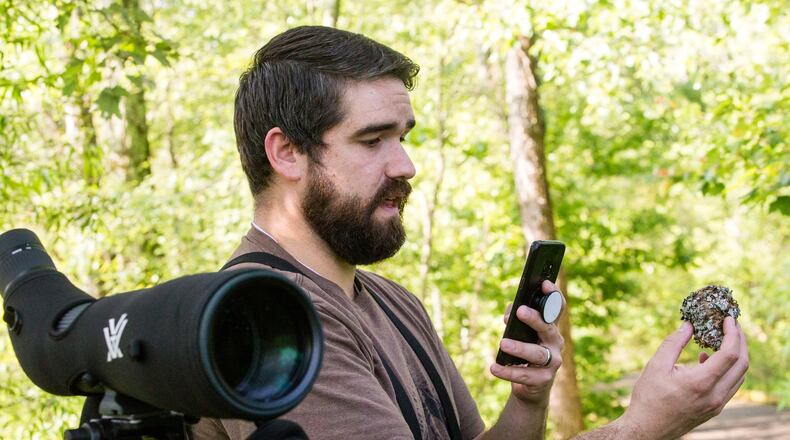Adam Betuel sat in the courtyard outside his apartment off Buford Highway, talking about birds, and getting interrupted.
“Birding seems to be one of those hobbies that people are picking up, now that they’re spending more time in their yards,” he said, before cocking an ear to the sky.
“Right now we’re hearing an American robin,” he said. Then the robin itself was interrupted by another song: “We’re now hearing the nice song of a house finch,” said Betuel, of a trill that sounded like a rapid-fire argument in the treble clef, with occasional exclamations. “It’s kind of a cool bird that is native to the western United States— sorry, not to interrupt my story, but we just heard a chimney swift as well.”
A broad-shouldered former football player, Betuel might not fit the conventional image of a birder, but he's been fascinated with birds since he was 16 years old. Now 35, he is a wildlife biologist, the director of conservation for the Atlanta Audubon Society, and easily distracted by the endangered chimney swift, whose "ch, ch, ch" vocalization sounds more like metal being filed than like a song.
Betuel and his colleagues at Atlanta Audubon are accustomed to leading Atlantans on regular birding outings, usually about 100 bird walks a year, plus lengthier trips to the coast and even to foreign countries.
Social distancing has made gathering in groups less practical, which is ironic because right now birding is taking flight.
Due to the COVID-19 crisis, Atlantans have been outdoors more, walking in parks, hiking in the woods or simply spending time in backyards. The shutdown coincided with the spring migration, which is peak time for bird watching. Betuel thinks this has boosted the hobby.
It is already a popular pastime. There are 40 million birders in the U.S. and more than 1,600 members of just the Atlanta Audubon Society chapter.
“There’s a huge uptick in the interest in birds,” agreed Dottie Head, director of membership and communication for Atlanta Audubon.
To help serve the demand, the staff at Audubon is now sponsoring weekly online bird walks, streamed on Facebook Live each Friday morning. Betuel and his colleagues will station themselves at different spots around the metro area — Arabia Mountain, the Peachtree Creek Greenway, Piedmont Park, the Dunwoody Nature Center — and each correspondent reports from their area.
Head serves as moderator and host, relaying questions from the audience to the birders, switching between the different birders. Sometimes 100 onlookers will tune in at a time.
Betuel recently took his listeners to the Constitution Lakes area in south DeKalb, famous for its "Doll's Head Trail," where he treated his audience to views of a yellow-crowned night heron. The day before his conversation in the courtyard was a big one; with the help of some birder friends, he'd spotted a Connecticut warbler at Henderson Park in Tucker, which was only the second time he's ever encountered that species. (This is a person with a 1,200-bird life list.)
Georgia is a crossroad for many bird species migrating from the Northeast to Florida and South America, and back again, which makes it a great place to watch birds, said Stan Tekiela.
Tekiela is the author of more than 200 books on birding, including “Birds of Georgia Field Guide.” His newest will be “Kids Guide to Birds of Georgia.”
We spoke with him on a morning after he’d risen before dawn at his Minnesota home to shoot photographs of ruffed grouse engaging in a ritual courtship behavior called “drumming.”
Tekiela said sales of feeders and poles are up, indicating a rising interest in our feathered friends.
He explains that feeding is for us, not the birds. “Most of our modern birds have been around for anywhere from three to five million years. They did fine before we ever started feeding them.”
To tune in to the virtual bird walk, go to the Atlanta Audubon Society's Facebook page.
Or just step outside the door. Betuel said you can easily identify 25 to 35 different species of birds in your own backyard. He’s discovered 80 in his apartment complex courtyard. It helps to use a guide, such as one of Tekiela’s or those by the dean of American birding, Roger Tory Peterson.
Also, said Betuel, listen. You can identify many birds using your ears first. Birding applications for mobile phone often include recordings of bird songs, which is one of the easy ways to become familiar with the “who cooks for you?” call of the barred owl or the “teakettle, teakettle” song of the Carolina wren.
Native plants will attract the kinds of insects that local birds appreciate, so grow those in your yard.
Tekiela also had this advice for those who want to observe birds.
— Sit still. “Don’t go wandering around. We are so used to just go, go, go, go. If you sit still for a while, it will be remarkable what unfolds.”
— Pay attention. During the interview with The Atlanta Journal-Constitution, he identified a dozen species in his Minnesota yard.
— Bring a pair of binoculars.
— Start early. “First thing in the morning is best. Midday is the worst. You can go out again in the evening, during the last two hours of light. We call that the shoulders of the day.”
The Atlanta Audubon Society is planning a "soft-opening" in June when staff will return to the office, and they will consider the possibility of organizing physical bird walks after that, said Dottie Head. For more information go to AtlantaAudubon.org.
LIVESTREAM
A virtual bird walk with the Atlanta Audubon Society
Streamed live every Friday 9 a.m. on Facebook.
About the Author
Keep Reading
The Latest
Featured








